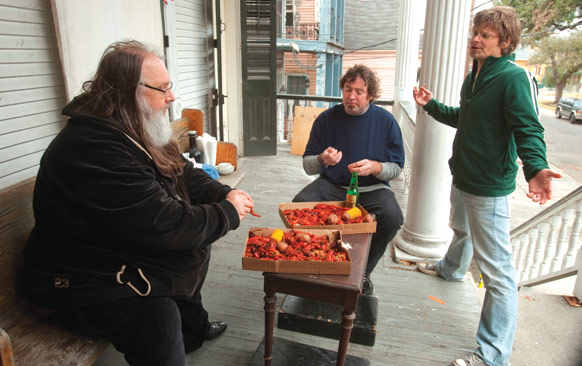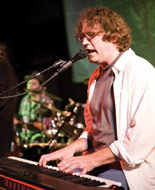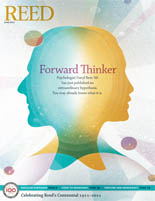
IRIS login | Reed College home Volume 90, No. 2: June 2011
The Showman’s Doppelganger (continued)

Xeroxing a mirror: Davis (center, munching) and actor Steve Zahn (right, scoffing) who plays Davis on TV. Photo by Paul Schiradi / courtesy of HBO
The show has definitely given Davis’s career a boost. He is about to release his second album. His gigs are drawing bigger crowds. And in his day job as a public school music teacher, he recently landed the perfect gig: teaching gifted students part time at Audubon Charter School, an only-in-New Orleans creation that combines Montessori and French immersion programs.
The flexibility is critical. After all, Davis needs the wiggle room for late-night rehearsals, lost car keys, fever dream songwriting sessions, monster hangovers, and, of course, calls from the Treme creative crew.
Davis has helped the show far beyond the confines of the character Davis McAlary, according to Blake Leyh, the show’s music supervisor. Frequently, he says, Davis plays the role of ambassador and tour guide. “We have spent more than a few evenings together in dive bars listening to deafening sousaphones, and Sunday afternoons in the streets following a second line,” Leyh says. “And Davis was the first person to take me to see the horror-punk band Balzac; a memorable evening involving Sazeracs and absinthe that ended with me dragging him from his car to his doorstep.”
The creative chaos—and occasional overindulgence—that Davis is known for in real life has become an important dynamic of the McAlary character. One of the best descriptions of the TV Davis comes from author Constance Ash, who blogs about Treme on the site Back of Town.
“It’s not an easy thing to be a society’s energetic, 24/7 King of Absurdity—the clown in Shakespeare, the Fool in the Tarot, the ruler of Mis-rule for feasts and Uncommon Days, Papa Legba in Haitian Vodún, Eleggua-Eshu of Ifá’s system of divination—the opener of the ways among the worlds, owner of the crossroads, the irresistible force of chaos, that turns all upside down and leaves behind a new order.”
That’s a lofty description to attach to a TV character, but can it be applied to Davis Rogan in real life? Is the TV Davis an example of art imitating life, or is it the other way around? And where exactly is the line between fact and fantasy when it comes to Davis and the show’s often gut-wrenching depiction of New Orleans?
Some perspective was offered by Jimbo Walsh, a master bass player and frequent sideman in Davis’s bands. Walsh, whose father and mother were Reed graduates in the late ’40s, says Davis has remained the same outsized New Orleans character he’s always been, despite his newfound notoriety. In his opinion, the TV Davis comes across tame compared to the real thing.
“There was a strange moment on my first day on the set. They were portraying Davis’ apartment and I thought, “They’ve even had to tone this down,” Walsh said. “I really think the real Davis is just too large to be captured, even by such amazing TV talents. They’re fortunate to come across a character with such a wealth of stories. Davis is pure New Orleans.”
As Rogan expressed it in the song “The Real Davis:”
“So how does it feel to have a character loosely based on you in a TV show?
And is it surreal, like you’re in a play?
What can I say?
It’s just my everyday.

STOP PRESS
Davis and his New Orleans All Star Rhythm & Blues Review will play at Reed for Reunions.
See reunions.reed.edu.
To hear Davis’ music, visit davisrogan.com
- Previous Page
- 1
- 2
- 3
- Next Page


LATEST COMMENTS
steve-jobs-1976 I knew Steve Jobs when he was on the second floor of Quincy. (Fall...
Utnapishtim - 2 weeks ago
Prof. Mason Drukman [political science 1964–70] This is gold, pure gold. God bless, Prof. Drukman.
puredog - 1 month ago
virginia-davis-1965 Such a good friend & compatriot in the day of Satyricon...
czarchasm - 4 months ago
John Peara Baba 1990 John died of a broken heart from losing his mom and then his...
kodachrome - 7 months ago
Carol Sawyer 1962 Who wrote this obit? I'm writing something about Carol Sawyer...
MsLaurie Pepper - 8 months ago
William W. Wissman MAT 1969 ...and THREE sisters. Sabra, the oldest, Mary, the middle, and...
riclf - 10 months ago